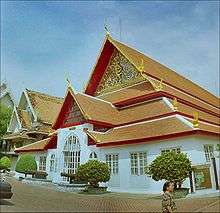Siriraj Medical Museum
The Siriraj Medical Museum, nicknamed the Museum of Death, is a medical museum in Bangkok, Thailand. Siriraj Medical Museum is open to the public and is a valuable resource for medical professionals and students. This museum consists of seven small medical museums:Siriraj Bimuksthan Museum, Ellis Pathological Museum, Congdon Anatomical Museum, Songkran Niyomsan Forensic Medicine Museum, Parasitological Museum, Touch Museum in Honor of Queen Mother Sirikit, and Sood Sangvichien Prehistoric Museum Laboratory.[1]
Ellis Pathological Museum
As the very first museum to be part of Siriraj Hospital, the Ellis Pathological Museum was founded by Professor Dr. Aller G. Ellis, MD, an American pathologist who began the practice of collecting disease-identified specimens of patients for his pathology class. The museum showcases the top killers of Thai people, heart disease and cancer, and different types of congenital anomalies along with proper treatment and preventive measures.
Congdon Anatomical Museum
Understanding human anatomy is at the core of the study of medicine. This museum has a collection, established by Dr Edgar Davidson Congdon, of more than 2,000 organs available for anatomical education. The museum displays the anatomical structure of all the systems of the human body, ranging from conception to reproductive age. Different forms of multiple births can be found on display. The range of muscles in the human body, the smallest of which is the size of an eyelash and the biggest of which is the size of a leg can also be seen. On display is a masterful dissection of the whole-body nervous and arterial system by Dr Patai Sirikarun, the one and only exhibit of its kind in the world.
Sood Sangvichien Prehistoric Museum and Laboratory
In 1960, Dr Sood Sangvichien, a specialist in anatomy and anthropology, joined an excavating mission at the archaeological site at Chorakhe Phueak in Kanchanaburi Province. The site is considered to be one of Thailand's most significant prehistoric excavation sites. There, he had the opportunity to study the tools, appliances, ornaments, and earthenware that were buried with the skeletons. He collected these objects and they became the first exhibits at his museum, officially open to the public in 1972. The museum takes visitors back to prehistoric civilization, when pieces of a Homo erectus skeleton known as "Lampang man" were found in Thailand. "Lampang man" lived approximately 1,000,000 – 400,000 years ago, making him a contemporary of "Peking man". The exhibit includes tools from three different ages, the Paleolithic, Mesolithic and Neolithic, aged over 1,000,000 – 4,000 years, as well as beads, colourful stones and various designs of painted earthenware.
Parasitology Museum
Dr Vichitr Chaiyaporn, the founder of this museum, collected parasites from his patients. They are displayed here with a presentation of their life cycle and natural habitat. A wide variety of parasites, ranging from those that are not visible to the naked eye (protozoa), to those up to a metre-long (flat worms) are on display, in addition to information about types of food, cooking processes favouring growth of the parasites, disease-carrying insects, venomous animals, and preventive measures.
Songkran Niyomsan Forensic Medicine Museum

Forensic medicine is the application of medical and scientific methodology to the identification of the causes of unnatural death. The exhibits include displays of skulls and various body parts in glass cases, many of them from murder victims, evidence that Dr Songkran Niyomsan, a forensic pathologist, collected in the course of his career.
This museum contains the mummified remains of the first known serial killer in modern Thai history. Chinese Si Ouey Sae Urng, born in 1927, was falsely referred to as "Si Quey" in the exhibition. The name part "Sae" indicates a Chinese clan name, in this case the family of Urng.[2][3] Si Ouey emigrated to Thailand shortly after the Second World War. He was employed as a gardener in Noen Phra, 200 kilometers south of Bangkok.
He was called a cannibal. Between 1954 and 1958, he was charged with the murder of seven children in Prachuap Khiri Khan Province, Nakhon Pathom, Bangkok, and Rayong. When he was captured in 1958, he was trying to burn the body of an eight-year-old. He admitted he had killed the boy and taken out the heart, liver, and kidneys for later dining.[4]
After a trial that lasted only nine days, he was sentenced to life imprisonment. In the second instance, the appeal procedure ended with the death penalty. On 17 September 1959, he was executed by a firing squad. The Siriraj Medical School requested his body for anatomical studies.[1] He was then embalmed and exhibited in the Siriraj Medical Museum with the label "cannibal" as a deterrent to others[5][6] Even today (2019), parents and grandparents warn young children when it gets dark to no longer take to the streets. "The child eater Si Ouey is coming to get you".[4]
References
- Chaiyong, Suwitcha (17 June 2019). "Grisly guidance". Bangkok Post. Retrieved 18 June 2019.
- somsaktam, Author (2018-03-13). "แซ่ของคนจีน". มรดกวัฒนธรรมจีน Chinese cultural heritage. Retrieved 2019-05-23.
- "โรงเรียนภาษาและภูมิปัญญาตะวันออก OKLS : เรียนภาษาจีน เรียนภาษาญี่ปุ่น เรียนรู้ภาษาตะวันออก เรียนรู้ภาษาโลก - หลักในการเดาแซ่". www.okls.net. Retrieved 2019-05-23.
- RND (27 May 2019). "Mörder im Glaskasten: Thailand streitet über Leichnam im Museum". Hannoversche Allgemeine. Retrieved 18 June 2019.
- "Hospital removes 'cannibal' sign from Si Quey corpse display". The Nation. 31 May 2019. Retrieved 18 June 2019.
- Dillon, Conor (7 March 2012). "Dead Baby Watching at Bangkok's Medical Museum". Vice. Retrieved 18 June 2019.
